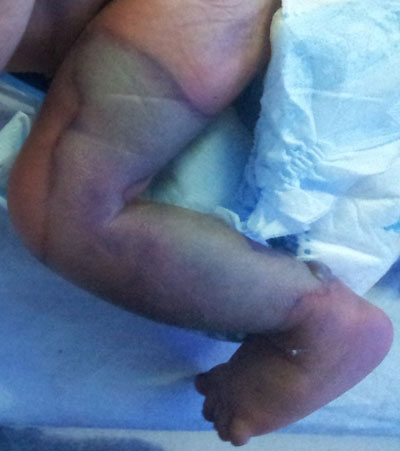|
|
|
Indian Pediatr 2016;53: 439 |
 |
Deep Vein Thrombosis Secondary to Early Onset
Sepsis in a Neonate
|
|
*Bharat Kansal and Naveen G Nadig
Department of Paediatrics, Bapuji Child Health
Institute and Research Center, JJMMC, Davangere, Karnataka. India.
Email: [email protected]
|
|
A term female newborn with birthweight of 2.7 kg delivered normally, was
admitted for transient neonatal respiratory distress and maternal
history suggestive of chorioamniotis. At 28 hours of life, baby’s left
lower limb turned edematous and bluishish-gray till 5 cm above ankle
which gradually progressed over next 12 hours (Fig. 1).
Investigations revealed a C-reactive protein of 9 mg/dL, Immature to
total neutrophil ratio 0.4 and total neutrophil count of 1800/mm
3
suggestive of positive sepsis screen. Doppler ultrasound documented a
thrombosis of the ileo-femoral segment. At 48 hours of life, she had
features of disseminated intravascular coagulation with Prothrombin time
of 44 s (control 13 s), activated partial thromboplastin time of 56 s
(control 34 s), platelet count of 43 x 109/L
and fibrinogen level of 50 mg/dL (normal 150-250 mg/dL). Blood Culture
showed growth of coagulase negative staphylococcus. The infant was
managed symptomatically, but she died at 65 hours of life.
 |
|
Fig. 1 Bluish-gray discoloration of left lower limb.
(See color image at website)
|
Neonates have the highest risk for
pathologic thrombosis among pediatric patients [1]. The most important
risk factors are iatrogenic factors, including indwelling umbilical
catheters or central catheters. Other risk factors include asphyxia,
dehydration, sepsis, cardiac disease, respiratory distress syndrome
(RDS), disseminated intravascular coagulation, congenital thrombophilia
(i.e., protein C or protein S deficiency), maternal diabetes
mellitus, and passive transfer of maternal antiphospholipid antibodies
[2]. Neonatal thrombotic events are often reported in low birth weight
preterm neonates [3]. Neonates with sepsis develop an acquired
pro-thrombotic state due to increased consumption of already limited
supplies of coagulation inhibitors. Ongoing consumption of coagulation
factors and platelets results in microcirculatory thrombosis, likely
contributes to sepsis-induced multi-organ failure and death [4]. When to
treat thrombosis in neonates is a challenging question for everybody
involved in the care of these infants. Since withholding anticoagulation
is an equally active decision as commencing treatment, the individual
risk/benefit ratio has to be carefully considered [4].
References
1. Saxonhouse MA. Thrombosis in the neonatal
intensive care unit. Clin Perinatol. 2015;42:651-73.
2. Kim SS, Park IS, Hong HS. Neonatal arterial
thromboembolism and limb loss following respiratory distress syndrome:
Case report. Arch Argent Pediatr. 2015;113:e157-60.
3. Van Elteren HA, Veldt HS, Te Pas AB, Roest AA, Smiers
FJ, Kollen WJ, et al. Management and outcome in 32 neonates with
thrombotic events. Int J Pediatr. 2011;2011:217564.
4. Meadow W, Frain L, Ren Y, Lee G, Soneji S, Lantos
J. Serial assessment of mortality in the neonatal intensive care unit by
algorithm and intuition: certainty, uncertainty, and informed consent.
Pediatrics. 2002;109:878-86.
|
|
|
 |
|

